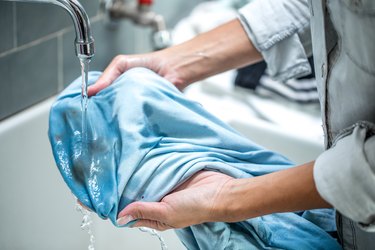
Although many people know that acetone removes nail polish, they may not realize that it also has many other uses. Acetone is a solvent used in other household products, like personal care items and cosmetics. It is also a highly effective stain remover regardless of which household product you happen to have that contains it.
Getting Out Stains With Acetone
Video of the Day
The most obvious kind of stain that acetone can remove is nail polish itself, but it is also good at removing paint and ink stains. If you choose to use acetone in this manner, you'll need to be very cautious. While you can use acetone on cotton clothes or other man-made materials, you should not apply it to fine natural fibers, like wool or silk. Read the label first to see if the item is washable. In addition, if the fabric contains acetate, modacrylic or triacetate, use a nonacetone nail polish remover.
Video of the Day
If the stain is still wet, dab it with a clean, white cloth to remove as much of the mark as you can. For washable fabrics, use a white cloth or clean sponge and dab on a little bit of the acetone. Using a light hand, work from the outside in and keep using clean parts of the sponge or cloth for each motion.
When you cannot see the stain any longer, rinse it in cool water and wash like you normally would. To remove ink stains, combine one part acetone and two parts water, dip in a cotton ball and dab on the ink stain until it goes away.
Acetone on Black Clothes
Can you use acetone on black clothes? The answer is yes, but you may not have much success. Most experts agree that this won't work as well as using acetone on lighter-colored cloth.
Whenever you are trying a cleaning solvent on fabric, test it on a small, inconspicuous area first. Dab on just a bit and see if it changes the color or damages the fabric in any way. You can also try using nonacetone nail polish remover on black clothes, but there are no guarantees that this will prove fruitful.
Other Uses for Acetone
Acetone has many other uses. To start, it can be used to remove melted plastic from metal items. If your plastic spatula is bonded onto a cooking pot, you may be able to save it. Wait until everything has cooled down. Dip a rag in acetone and wipe at the melted parts until they loosen. Then, be sure to thoroughly clean everything before cooking with it again.
Acetone can also smooth away scratches on hard, plastic items, like furniture, watch faces and picture frames. Use a cotton swab and just a bit of acetone and rub slowly and gently. It can also remove tea and coffee stains from glass and ceramic mugs. Again, wash these very well afterward. You may also use acetone to remove scuff marks from floors and to dissolve dried superglue.
Acetone can be used to remove paint splotches from walls and to disinfect small grooming tools, like nail clippers, razors and tweezers. You can also clean a porcelain tub with acetone. Be sure to wear cleaning gloves and a mask if you find the smell irritating and ventilate the area well. To clean porcelain tubs, mix equal parts of water and acetone, apply it to the dirty parts with a rag and scrub with a nonabrasive brush. Use soap and water to rinse anything you clean with acetone.